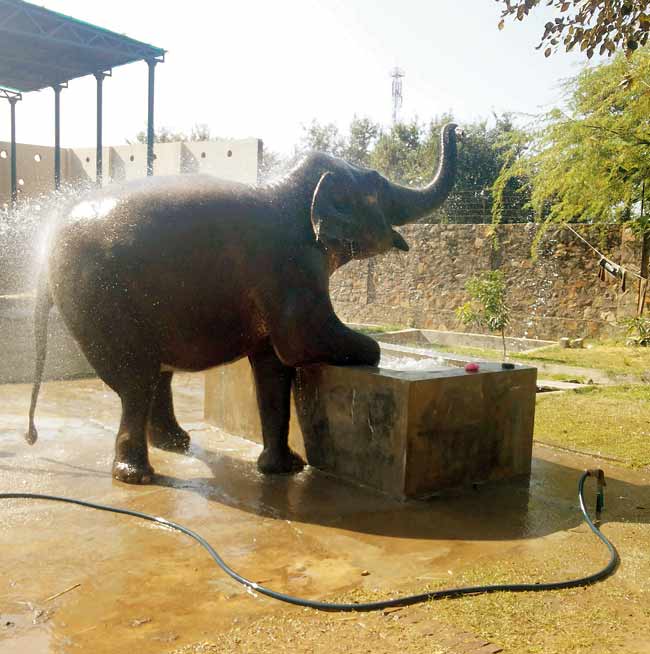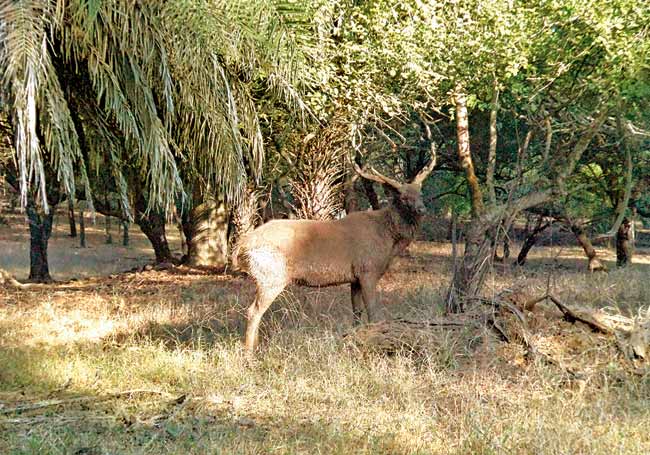Speaking in hushed tones, straining the ears to catch the warning cry of a deer and the sheer joy of looking into the eyes of a tiger — a visit to the Ranthambore National Park is a four-hour, action-packed thriller, finds Dhiman Chattopadhayay

Hush now. We can spot the pugmarks. He is nearby. Can you smell him?” We breathe in deeply, the forest air cleansing our city-chocked lungs. And then we see him. Proud, lethal and very, very close.” Many Ranthambore travel diaries will begin with similar lines. After all, it is tiger territory and a sighting of the big cat is the icing on the cake for animal lovers, though there are hundreds of other flora and fauna to watch out for in the massive reserve forest.

The majestic tiger takes a walk at the Ranthambore National Park. Pic Courtesy Oberoi Vanyavilas
We start our tiger safari in specially-designed camouflage print jeeps at 7 am — the eight-seater vehicles are good for the rough and rocky forest terrain, though the ride remains bumpy. Since the early morning air is crisp and cold, we are given blankets and face masks. The latter helps battle the wind chill and also prevents all the dust that the vehicle throws up from clogging nostrils.
ADVERTISEMENT

While a langur breaks into a run with his baby
The state forest department provides guides and tiger trackers — the cost is included in the price you pay for the vehicle seats. Though you can also book an entire jeep, we opt to share one with an enthusiastic British couple who are on their third visit to Ranthambore.

Some hotels allow their guests to bathe pet elephants
After travelling deep into the green forest, we spot a few deer, mongoose and even a whole family of sunbathing crocodiles. Then, almost as if the final act of a drama is beginning — our tracker tells us it is time for serious business.
Tracking the king
Tracking a tiger must rank as one of the hardest jobs on earth. They are shy, elusive creatures and can only be followed by sighting pug marks, sniffing the distinct smell of the tiger and listening to the call of the barking deer, chatter of the monkeys and warning call of the birds. All these help the expert tracker guide the vehicle closer and closer to the big cat. We sniff, strain our ears, look eagerly at the neelgais in the hope that they would bark — for the better part of two hours. And then, just as we have all but given up, just like that, he is there in front of us. Partly hidden by a bush, but the stripes and the brightly burning eyes unmistakable. A low growl emanates from the king. ‘Wow’, ‘ooh’ and similar exclamations erupt and we fumble with the camera.

An aerial view of the beautiful Oberoi Vanyalvilas at Ranthambore
After a couple of minutes that seem to stretch on forever, the tiger ambles away, perhaps bored of the regular intrusion into its privacy. We breathe again. After that, everything seems to pale in comparison. But the bright chatter of the monkeys, the flash of startling blue of a flying kingfisher bird and the large sambhar that comes sniffing at our jeep cannot be discounted. We return to the hotel, after the four-hour jungle safari.

A neelgai pauses for a photo-op. Pics/Dhiman Chattopadhyay
Of course, Ranthambore is a sight for the sore eyes for its verdant green cover, too. Wherever you look, there are a variety of trees, and birds that are pleasing to the eye. A walk in a garden is halted when a family of monkeys decides to cross the road on their evening walk — grandparents, parents, children and neighbours — there seemed to be a whole colony on the move. Thanks to Arjun, the resident naturalist at the Oberoi Vanyavilas — our home for the night — we go on a magical walk to find jungle babblers, plum headed parakeets, click pictures of the white-bellied Drongo and say hellow to the purple sunbird.
Ranthambore today has just 49 tigers left, but this number is growing thanks to some great conservation work. Like most parts of Rajasthan, it attracts a large number of Indian and foreign tourists thanks to its progressive tourism department and easy connectivity between the tourist spots.
There are a number of hotels and lodges where you can stay on your visit to Ranthambore. The Jhoomar Mahal is run by the RTDC and has an enviable location — right on top of a hill inside the forest. It is old-fashioned, quaint and with a bright pink façade, but then, jungle rules are different from that of the mundane city life, right?
The food in Ranthambore, as with the rest of Rajasthan, is rich and varied. From the famed Lal Maas (meat cooked in a red chilly paste gravy) to the vegetarian options, there is something for everyone. But the pure air and walking around gives you a good appetite most of the time, so you can dig in, guilt-free.
Our hotel is a royal experience, in more ways than one. Located just outside the main entrance to the forest, it is built to blend with the natural surroundings. Every guest is assigned a luxury tent — 1000 square-feet suites with luxury baths and king-sized beds. In the evenings, a bonfire is lit, with traditional Rajasthani folk singers playing lively tunes as you nurse a drink.
A breakfast on the sprawling lawns is another special — it is nice to be served a cuppa and croissants under the canopy of a tree. From the observatory one can look at the sprawling forest, a watering hole and far into the horizon — all green with vegetation. And somewhere, amidst all that foliage, you know that watchful eyes check your every move, even as it hunts for its preys closer to hand. It’s the land of the tiger, and they have earned their stripes in the wild over centuries.
 Subscribe today by clicking the link and stay updated with the latest news!" Click here!
Subscribe today by clicking the link and stay updated with the latest news!" Click here!







